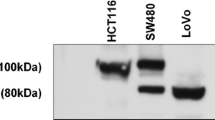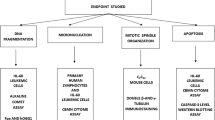Abstract
Purpose
The mismatch repair (MMR) system plays a major role in mediating the cytotoxicity and clastogenicity of agents generating O6-methylguanine in DNA. Loss of MMR has also been associated with tumor cell resistance to the cytotoxic effects of 6-thioguanine and cisplatin and with hypersensitivity to N-(2-chloroethyl)-N′-cyclohexyl-N-nitrosourea (CCNU). The aim of the present investigation was to elucidate the role played by the MMR system in the generation of chromosomal damage in cells exposed to 6-thioguanine, cisplatin or CCNU.
Methods
The MMR-proficient cell lines TK6 and HCT116/3-6, and their MMR-deficient counterparts MT1 and HCT116, were treated with 6-thioguanine, cisplatin or CCNU, and analyzed for cell growth inhibition and chromosomal damage. As a control, similar experiments were performed with the methylating agent temozolomide.
Results
Cytotoxicity, chromosomal aberrations and sister chromatid exchanges induced by 6-thioguanine and temozolomide were significantly reduced in the MMR-deficient cell lines with respect to their MMR-proficient counterparts. In contrast, although conferring some protection against cytotoxicity, the loss of MMR did not affect cytogenetic damage induced by cisplatin. CCNU produced comparable levels of cytotoxicity, chromosomal aberrations and sister chromatid exchanges in both MMR-proficient and MMR-deficient cell lines.
Conclusions
The MMR system is involved in the generation of chromosomal damage in cells exposed to 6-thioguanine. The system does not play a relevant role in the generation of chromosomal damage in cells treated with CDDP and does not confer protection against the clastogenic effects of CCNU, at least in the cell lines investigated.



Similar content being viewed by others
Abbreviations
- BG:
-
O6-Benzylguanine
- CCNU:
-
N-(2-Chloroethyl)-N′-cyclohexyl-N-nitrosourea
- CDDP:
-
cis-Diamino-di-chloro-platinum (II)
- MGMT:
-
O6-Methylguanine-DNA methyltransferase
- MMR:
-
Mismatch repair
- MTT:
-
3-(4,5-Dimethylthiazol-2-yl)-2,5-diphenyltetrazolium bromide
- sce:
-
Sister chromatid exchanges
- 6-TG:
-
6-Thioguanine
- TMZ (temozolomide):
-
8-Carbamoyl-3-methyl-imidazo[5,1-d]-1,2,3,5-tetrazin-4(3H)-one
References
Aebi S, Fink D, Gordon R, Kim HK, Zheng H, Fink JL, Howell SB (1997) Resistance to cytotoxic drugs in DNA mismatch repair-deficient cells. Clin Cancer Res 3:1763
Allan MJ, Engelward BP, Dreslin AJ, Wyatt MD, Tomasz M, Samson LD (1998) Mammalian 3-methyladenine DNA glycosylase protects against the toxicity and clastogenicity of certain chemotherapeutic DNA cross-linking agents. Cancer Res 58:3965
Aquilina G, Ceccotti S, Martinelli S, Hampson R, Bignami M (1998) N-(2-chloroethyl)-N′-cyclohexyl-N-nitrosurea sensitivity in mismatch repair-defective human cells. Cancer Res 58:135
Armstrong MJ, Galloway SM (1997) Mismatch repair provokes chromosome aberrations in hamster cells treated with methylating agents or 6-thioguanine, but not with ethylating agents. Mutat Res 373:167
Bean CL, Bradt CI, Hill R, Johnson TE, Stallworth MV, Galloway SM (1994) Chromosome abs: persistence of alkylation damage and modulation of O6-alkylguanine-DNA alkyltransferase. Mutat Res 307:67
Beranek DT (1990) Distribution of methyl and ethyl adducts following alkylation with monofunctional alkylating agents. Mutat Res 231:11
Bodell WJ, Aida T, Berger MS, Rosenblum ML (1986) Increased repair of 1 O6-alkylguanine DNA adducts in glioma-derived human cells resistant to the cytotoxic and cytogenetic effects of 1,3-bis(2-chloroethyl)-1-nitrosurea. Carcinogenesis 7:879
D'Atri S, Tentori L, Lacal PM, Graziani G, Pagani E, Benincasa E, Zambruno G, Bonmassar E, Jiricny J (1998) Involvement of the mismatch repair system in temozolomide-induced apoptosis. Mol Pharmacol 54:334
D'Incalci M, Citti L, Taverna P, Catapano CV (1988) Importance of DNA repair enzyme O6-alkyltransferase (AT) in cancer chemotherapy. Cancer Treat Rev 15:279
Dolan EM, Moshel RC, Pegg AE (1990) Depletion of O6-alkylguanine-DNA alkyltransferase activity by O6-benzylguanine provides a means to evaluate the role of this protein in protection against carcinogenic and therapeutic alkylating agents. Proc Natl Acad Sci U S A 87:5368
Duckett DR, Drummond JT, Murchie AI, Reardon JT, Sancar A, Lilley DM, Modrich P (1996) Human MutSα recognizes damaged DNA base pairs containing O-6-methylguanine O-4-methylthymine, or the cisplatin-d (GpG) adduct. Proc Natl Acad Sci U S A 93:6443
Durant ST, Morris MM, Illand M, McKay HJ, McKormick C, Hirst GL, Borts RH, Brown R (1999) Dependence on RAD52 and RAD1 for anticancer drug resistance mediated by inactivation of mismatch repair genes. Curr Biol 9:51
Fink D, Nebel S, Aebi S, Zheng H, Cenni B, Nehmè A, Christen RD, Howell SB (1996) The role of DNA mismatch repair in platinum drug resistance. Cancer Res 56:4881
Fink D, Aebi S, Howell SB (1998) The role of DNA mismatch repair in drug resistance. Clin Cancer Res 4:1
Fiumicino S, Martinelli S, Colussi C, Aquilina G, Leonetti C, Crescenzi M, Bignami M (2000) Sensitivity to DNA cross-linking chemotherapeutic agents in mismatch repair-defective cells in vitro and in xenografts. Int J Cancer 85:590
Galloway SM, Greenwood SK, Hill R, Bradt CI, Bean CL (1995) A role for mismatch repair in production of chromosome aberrations by methylating agents in human cells. Mutat Res 346:231
Goldmacher VS, Cuzick RA, Thilly WG (1986) Isolation and partial characterization of human cell mutants differing in sensitivity to killing and mutation by methylnitrosurea and N-methyl-N′-nitro-N-nitrosoguanidine. J Biol Chem 261:12462
Hansen MB, Nielsen SE, Berg K (1989) Reexamination and further development of a precise and rapid dye method for measuring cell growth/cell kill. J Immunol Methods 119:203
Hawn MT, Umar A, Carethers JM, Marra G, Kunkel TA, Boland CR, Koi M (1995) Evidence for a connection between the mismatch repair system and the G2 cell cycle checkpoint. Cancer Res 55:3721
Jiricny J (1998) Eukaryotic mismatch repair: an update. Mutat Res 409:107
Jiricny J, Nystrom-Lahti M (2000) Mismatch repair defects in cancer. Curr Opin Genet Dev 10:157
Kaina B, Ziouta A, Ochs K, Coquerelle T (1997) Chromosomal instability, reproductive cell death and apoptosis induced by O6-methyl-guanine in Mex−, Mex+ and methylation-tolerant mismatch repair compromised cells: facts and models. Mutat Res 381:227
Karran P (2001) Mechanisms of tolerance to DNA damaging therapeutic drugs. Carcinogenesis 22:1931
Karran P, Bignami M (1992) Self-destruction and tolerance in resistance of mammalian cells to alkylation damage. Nucleic Acids Res 20:2933
Kat A, Thilly WG, Fang WH, Longley MJ, Li GM, Modrich P (1993) An alkylation-tolerant mutator human cell line is deficient in strand-specific mismatch repair. Proc Natl Acad Sci U S A 90:6424
Koi M, Umar A, Chauhan DP, Cherian SP, Carethers JM, Kunkel TA, Boland CR (1994) Human chromosome 3 corrects mismatch repair deficiency and microsatellite instability and reduces N-methyl-N′-nitrosoguanidine tolerance in colon tumor cells with homozygous hMLH1 mutation. Cancer Res 54:4308
Liu L, Markowitz S, Gerson SL (1996) Mismatch repair mutations override alkyltransferase in conferring resistance to temozolomide but not to 1,3-bis (2-chloroethyl)nitrosourea. Cancer Res 56:5375
Ludlum DB (1990) DNA alkylation by haloethylnitrosureas: nature of modifications produced and their enzymatic repair or removal. Mutat Res 233:117
Mello JA, Acharya S, Fishel R, Essingmann JM (1996) The mismatch-repair protein hMSH2 binds selectively to DNA adducts of the anticancer drug cisplatin. Chem Biol 3:579
Modrich P (1997) Strand-specific mismatch repair in mammalian cells. J Biol Chem 272:24727
Papadopoulos N, Nicoladesi NC, Wei YF, Ruben SM, Carte KC, Rosen CA, Haseltine WA, Fleishmann RD, Fraser CM, Adams MD, Venter JC, Hamilton SR, Petersen GM, Watson P, Lynch HT, Peltomaki P, Mecklin JP, de la Chapelle A, Kinzler KW, Vogelstein B (1994) Mutation of a mutL homolog in hereditary colon cancer. Science 263:1625
Pegg AE, Dolan ME, Moschel RC (1995) Structure, function, and inhibition of O6-alkylguanine-DNA alkyltransferase. Prog Nucleic Acid Res Mol Biol 51:167
Perry P, Wolff S (1974) New Giemsa method for the differential staining of sister chromatids. Nature 251:156
Roberts JJ, Friedlos F (1987) Quantitative estimation of cisplatinum induced DNA interstrand cross-links and their repair in mammalian cells: relationship to toxicity. Pharmacol Ther 34:215
Robins P, Harris AL, Lindahl T (1983) Cross-linking of DNA induced by chloroethylnitrosurea is prevented by O6-methylguanine-DNA methyltransferase. Nucleic Acids Res 22:7743
Skopek TR, Liber HL, Penman BW, Thilly WG (1978) Isolation of a human lymphoblastoid line heterozygous at the thymidine kinase locus: possibility for a rapid human cell mutation assay. Biochem Biophys Res Commun 84:411
Swann PF, Waters TR, Moulton DC, Xu YZ, Zheng Q, Edwards M, Mace R (1996) Role of postreplicative DNA mismatch repair in the cytotoxic action of thioguanine. Science 273:1109
Vaisman A, Varchenko M, Umar A, Kunkel TA, Risinger JI, Barrett JC, Hamilton TC, Chaney SG (1998) The role of hMLH1, hMSH3, and hMSH6 defects in cisplatin and oxaliplatin resistance: correlation with replicative bypass of platinum-DNA adducts. Cancer Res 58:3579
Vernole P, Tedeschi B, Caporossi D, Maccarrone M, Melino G, Annicchiarico-Petruzzelli M (1998) Induction of apoptosis by bleomycin in resting and cycling human lymphocytes. Mutagenesis 13:209
Watson AJ, Margison GP (1999) O6-Alkylguanine-DNA alkyltransferase assays. In: Brown R, Boeger-Brown U (eds) Cytotoxic drug resistance mechanisms. Humana Press, Totowa, p 167
Acknowledgements
The authors thank Prof. E. Bonmassar for his valuable advice, and Mr. G. Bonelli for his skilful technical assistance. The research was partly supported by grants from M.U.R.S.T to P.V., and partly by the Italian Ministry of Health.
Author information
Authors and Affiliations
Corresponding author
Rights and permissions
About this article
Cite this article
Vernole, P., Pepponi, R. & D'Atri, S. Role of mismatch repair in the induction of chromosomal aberrations and sister chromatid exchanges in cells treated with different chemotherapeutic agents. Cancer Chemother Pharmacol 52, 185–192 (2003). https://doi.org/10.1007/s00280-003-0660-6
Received:
Accepted:
Published:
Issue Date:
DOI: https://doi.org/10.1007/s00280-003-0660-6




